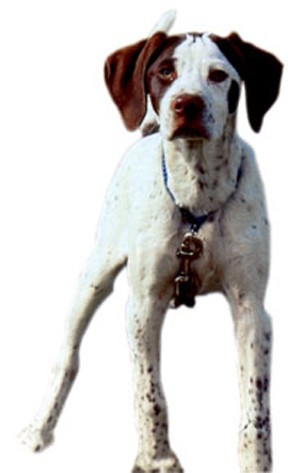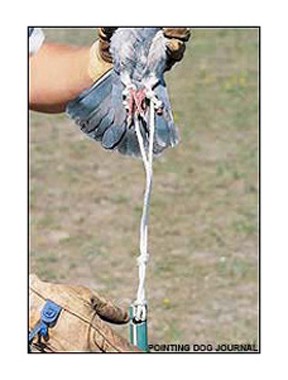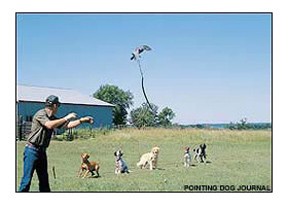



Pigeons and Scent



Since the real world is what it is, most of us have to work to support our habit, and bird fields are somewhere we have to drive to because all that many of us have is a backyard. Even those fields are rarely loaded with enough wild birds to train on, which forces us to consider other options. So how do we train our dogs on birds? The best and easiest of the available options is pigeons.
Why pigeons? First of all, they are both hardy and durable and can withstand the kind of use we give them. Fragile is not a word one considers when thinking of pigeons. They are readily and easily available from many sources, such as homing or racing pigeon clubs and breeders (they will sell reasonably or even give away birds not fast enough for racing; they probably won't sell you homing pigeons that can't home because they never came back), and can also be trapped from farms and other locations where they are considered a nuisance. In many states, feral pigeons are not held within game laws, but check your state to find out.
"Another good reason to train on pigeons is this: They stink."
Seriously, they put off enough scent that even we olfactory-challenged humans can smell'em if we try hard. The main use for birds, especially in the early stages of training, is to teach the dog to stop immediately on scent. Pigeons help this process along, thanks to the amount of scent.
The very best reason to train using pigeons is that they are not gamebirds, and therefore if we make a mistake in our training, it won't affect the dogs as much since we don't hunt or compete using pigeons.
Pigeons allow us some forgiveness in training. The dogs learn the difference after a while, and eventually pigeons become boring to them in comparison to wild birds, All they relate pigeons to training, not to hunting. They don't tend to relate the simple errors we humans make on training pigeons with the gamebirds they hunt, but the routine and training learned on pigeons will stay with the dog.
The pigeon's size and flight make it a great bird to build what we call "prey drive" in young dogs. Allowing them to build desire and get fired up about birds by chasing pigeons is great, because it gives them enthusiasm; yet we can use the same bird to take the chase out of the dog when it's time for more formal training to start, and then we don't carry any negative associations with us into the field when we start on gamebirds.
Hobbles help us control where a pigeon is planted in the field as well as controlling the distance the bird can fly. The hobbles we use are made of a soft nylon cord so they won't hurt the pigeon's legs.
To make your own set, start with a length of cord about two and a half feet long. Find the center of the length of cord and tie an overhand knot to divide it in half, leaving a loop in the center. This will be the spot where you will attach either a checkcord or hose.
To form the leg loops, you can buy the plastic toggles at a fabric store, or else tie a slipknot in each end of the cord. These will go around the legs of the bird. Place one loop over each of the pigeon's legs and snug them up tightly.
We attach the hobbles to either a short length of garden hose or snap it onto a checkcord. The checkcord gives the bird a limited range if held in your hand, and the length of hose will also weight the bird down so it can't fly too far. With both the checkcord and the hose, you can toss the bird, hobbles and all, into the air and it will fly a short distance before landing.
When using launchers, a very light length of cord tied to the launcher frame (about 30 feet or so) and attached to the hobbles will allow you to reuse the same bird rather than having to reload with a new bird each time.
The best thing about pigeons and launchers is that pigeons fly stronger and better than most pen-raised gamebirds. Alternatively, if you can raise some homing pigeons, they will fly back to their coop and you can use a fresh bird in the launcher each time. Often, feral pigeons will return to a coop as well once they have become accustomed to feeding there.
Our main goal when starting with pigeons is to teach our dogs to stop immediately on scent. In order for this to work, the dog first has to be fired up about birds. That's where the above-mentioned prey drive comes in. Pigeons are fast and strong enough fliers that dogs can't catch them. Allowing the dog to chase builds desire (they're just like us, always wanting what they can't get!), and if they chase enough birds, they'll learn that they can't catch them. At this point, we can introduce stopping on scent.
Always train with the idea being success for your dog. The more consistent successes they have, the faster they will learn.
Too often, people try to guide the dog to a planted bird (after all, we know where it is, and we're only trying to help our dog succeed), but this hinders the dog more than helps it. Instead, allow the dog to work the cover as if you have no idea where the bird is planted, and just follow along behind the checkcord. It's entirely possible your dog may run right over or into the first bird or two. This is not a problem; do not judge your dog! Usually, this will lead to a dog that is really looking for birds next time, and helps build enthusiasm. It's all about helping our dogs learn the rules of the game, and they don't learn if they don't get to make mistakes.
Learn to carefully read your dog, looking for signs it has scented a bird. These signs include more alertness, raising the head, ears perking, tail raised.
As soon as any one of these signs, however slight it may be, appears, the dog has found game. This doesn't mean the dog knows what it has found, just that an interesting smell is in the area. That's the time to gently stop the dog.
Once the dog is stopping on scent, taking the chase out becomes easy. We've already got the dog to stop, so all we have to do is keep it there, first with the checkcord, then with the e-collar on the flank after the dog has learned the whoa post drill thoroughly, and eventually we will move to just a soft "whoa" if needed (and if trained correctly, it rarely is needed). The best part of this is that we get to take out the chase yet keep the prey drive, giving the dog the intensity it needs to really shine.
The more controlled the training situation is in the early stages, the better. This means you will know exactly where the bird is, and can use the wind to your dog's advantage. Don't lead your dog to the bird, but it is important to be sure your dog comes in downwind of the planted bird. The breeze should be in your face, which in turn carries the scent directly to your dog. Ideally, we'd like the dog to catch scent at least 10 to 12 feet away from the planted bird.
So, here we are in the field. Our dog is quartering nicely in front of us on the checkcord, but missed the scent completely. Does that mean our dog has a poor nose? It's highly unlikely. Think about how dogs breathe. If, as your dog is going across in front of you, it happens to exhale instead of inhale, how can it possibly catch the scent? The hotter the day, the more your dog will pant, and this makes scenting even more difficult for them, since their respiration rate is faster, with more exhaling than usual.
Additionally, there are some days when scent conditions are so poor, it's better to not do any bird work. Conditions that can cause poor scent conditions are high humidity, very dry, and heat. Don't work on birds in these conditions, because it can negatively affect the dog's confidence. Use the available time to your best advantage, and find the right time for bird work. This may mean very early in the morning, when it is not too hot and there may be a little dew on the grass.
Always train with the idea being success for your dog. The more consistent successes they have, the faster they will learn. We have the ability to give them those successful experiences by setting up appropriate training situations and allowing them to learn by trial and error.